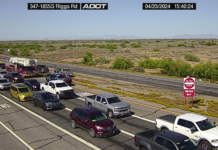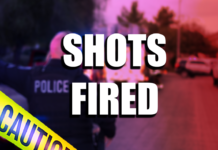
By Raquel Hendrickson
When an Amtrak train pulls into the Maricopa station, it does not stop just once.
The platform is only long enough to allow access to one baggage car and one passenger car. The train stops the first time for the first access, and then it pulls forward and stops again for access to more baggage and more passengers. And then it does so again.
It is a 10-minute procedure. For most of that time, the train is stopping the traffic flow on State Route 347.
It is why a proposal for moving the Amtrak station is an integral part of planning for an overpass across the Union Pacific Railroad tracks at SR 347.
The start of construction on the grade separation is at least five years away, but the plan has several moving pieces. Arizona Department of Transportation has its responsibilities, and the City of Maricopa has its tasks.
Among the latter is the Amtrak station, which will be in the path of the overpass, whatever the final design of the grade separation. Public Works Director Bill Fay said the move has two components. One is the concept plan for track alignment near Garvey Avenue, where the new station will be located. The other is the design of transportation center and alignment of Garvey itself.
The first component dealing with the railroad tracks is at about 30 percent design completion in manpower. Fay said on a typical road project, 30 percent is the last chance to make big changes.
“I’ve never been through a railroad right-of-way project that is entirely within the railroad’s right of way,” he said. “I don’t know that there are very big changes that one can make.”
Though the move of the Amtrak station west to the city’s Estrella Gin property involves Amtrak property and UPRR right of way, the early stages of design fall to the city. Amtrak officials consider the Maricopa staff to be spearheading the project and will say little to nothing about the plan.
Union Pacific has review powers but is equally reticent in the early stages. “UP is consulting on the track design, but other than that, we don’t have much to add,” said UPRR spokesman Francisco Castillo Jr.
“Hopefully at 60 (percent) but no later than 90, it will go before Union Pacific to review,” Fay said. “We would love for them to review it now, but their policy is 90 percent.”
UPRR has “relatively strong” veto power, Fay said. “But this makes sense. They don’t want to review it while it’s still in preliminary stages. But 90 percent is pretty deep in the process. The problem is their review can take up to 18 months. So that’s a little hard to swallow when you’ve got to get to 90 percent design first and then wait 18 months for them to review.”
He said UPRR reserves 18 months for review but does not always take 18 months. There is also the possibility Maricopa could submit its design plans before they are at 90 percent completion. In the meantime, ADOT and the city can be moving forward on the overpass project, Fay said.
Amtrak trains are not as long as the far-more-numerous freight trains on the UPRR lines but can hold up traffic even longer than the longest freight train.
Maricopa is the Phoenix station for Amtrak, a stopping point for lines between Los Angeles and New Orleans, or L.A. and Chicago (or just about anywhere else in the East if you make the right connections). Amtrak trains stop in Maricopa early in the morning – commuting time for many residents – and in the evening.
Fay said a preliminary project could be a temporary fix until the station is moved. That project would extend the asphalt platform east so it would be long enough for the train to pull off of SR 347.
The new station to be located at the Estrella Gin site on Garvey will be in what is currently being called a transportation center and a transit hub. The conceptual plan for that is at about 15 percent design, Fay said.
The civil conceptual design is contracted to a Phoenix firm.
“The piece that isn’t in there is, what is the new train station going to look like?” Fay said. “The city has money budgeted in its Capital Improvement Program (CIP) potentially to relocate the existing station to the new location.”
However, in the past some council members and some members of the Maricopa Historical Society have expressed an interest in creating a station that is a better aesthetic fit in the Heritage District. Though station design plans go to Amtrak at some point, Fay said Amtrak has expressed it “really does not care what the station looks like.”
If the city council does decide to go with a new building, the process of hiring an architect and other related tasks would be built into the timetable for the move. Ideas for a historic-looking station are mostly inspired by photos of the former station in Maricopa.
The ideas have been included in the Maricopa General Plan, and city staff has been asking for public feedback.
“The better info we get from the public the more reinforcement staff can portray to our leadership and say, ’Hey, the public wants to see this,’” senior planner Rudy Lopez said.
Lopez said when the project moves forward, the city should be working more closely with the historical society. “They’re a great organization and growing, so obviously that’s to our advantage,” he said. “We’re having this discussion now for the next generation of the city.”








![Who’s the Best Mom InMaricopa? Nominate now! Marlene Marshall, Christina Olivares, and Meghan Bremer. [Bryan Mordt]](https://www.inmaricopa.com/wp-content/uploads/2023/05/BCM_8465-218x150.jpg)


![Alleged car thief released without charges Phoenix police stop a stolen vehicle on April 20, 2024. [Facebook]](https://www.inmaricopa.com/wp-content/uploads/2024/04/IMG_5040-218x150.jpg)






